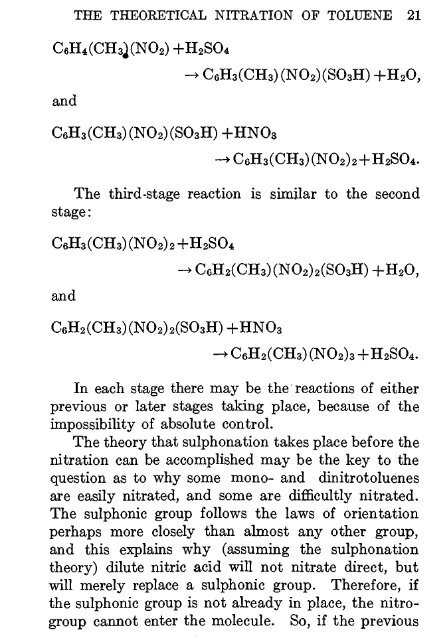TNT: Trinitrotoluenes and Mono and Dinitrotoluenes
TNT: Trinitrotoluenes and Mono and Dinitrotoluenes
TNT: Trinitrotoluenes and Mono and Dinitrotoluenes
Create successful ePaper yourself
Turn your PDF publications into a flip-book with our unique Google optimized e-Paper software.
<strong>and</strong><br />
THE THEORETICAL NITRATION OF TOLUENE 21<br />
2) +H2SO4<br />
C6H3(CH3)(NO2)(SO3H) +HNO3<br />
-* C6H3(CH3)(NO2)(SO3H) +H2O,<br />
The third-stage reaction is similar to the second<br />
stage:<br />
C6H3(CH3) (NO2)2 +H2SO4<br />
<strong>and</strong><br />
C6H2(CH3)(NO2)2(SO3H) +HNO3<br />
-* C6H2(CH3)(NO2)2(SO3H) +H2O,<br />
-> C6H2(CH3) (NO2)3 +H2SO4.<br />
In each stage there may be the reactions of either<br />
previous or later stages taking place, because of the<br />
impossibility of absolute control.<br />
The theory that sulphonation takes place before the<br />
nitration can be accomplished may be the key to the<br />
question as to why some mono- <strong>and</strong> dinitrotoluenes<br />
are easily nitrated, <strong>and</strong> some are difficultly nitrated.<br />
The sulphonic group follows the laws of orientation<br />
perhaps more closely than almost any other group,<br />
<strong>and</strong> this explains why (assuming the sulphonation<br />
theory) dilute nitric acid will not nitrate direct, but<br />
will merely replace a sulphonic group. Therefore, if<br />
the sulphonic group is not already in place, the nitrogroup<br />
cannot enter the molecule. So, if the previous
















